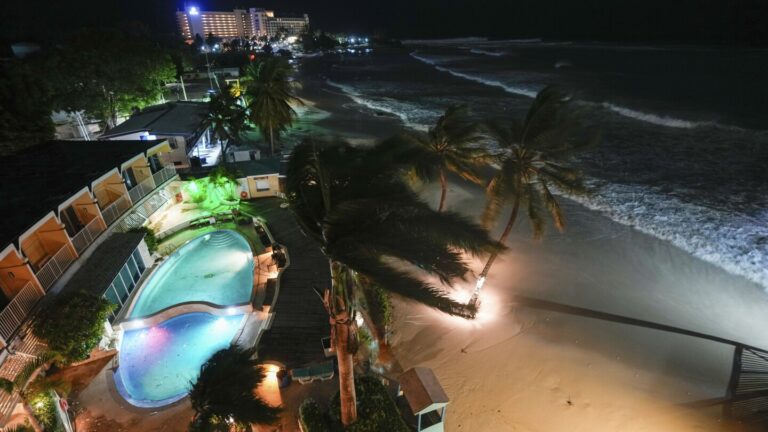SAN JUAN, Puerto Rico (AP) — Hurricane Beryl was approaching the southeastern Caribbean, and government officials late Sunday urged people to evacuate from the dangerous Category 3 storm.
The storm was expected to make landfall in the Windward Islands on Monday morning. Hurricane warnings were in effect for Barbados, St. Lucia, Grenada, Tobago and St. Vincent and the Grenadines.
“This is an extremely dangerous situation,” warned the US National Hurricane Center in Miami, saying Beryl was “projected to bring life-threatening strong winds and storm surge.”
Beryl was centered about 110 miles (175 km) south-southeast of Barbados early Monday. It had maximum sustained winds of 120 mph (195 kph) and was moving west at 20 mph (31 kph). It was a compact storm with hurricane-force winds out to 30 miles (45 km) from the center.
The storm reached Category 4 strength on Sunday before weakening slightly and was expected to fluctuate further in strength.
A tropical storm watch was issued for Martinique and Trinidad. A tropical storm watch was issued for the entire southern coast of Dominica and Haiti, and from Punta Palenque in the Dominican Republic west to the Haitian border.
Beryl was expected to pass just south of Barbados early Monday before becoming a major hurricane as it exited the Caribbean Sea toward Jamaica. It was expected to weaken by midweek but remain a hurricane as it heads toward Mexico.
Historic Hurricane
Beryl strengthened into a Category 3 hurricane on Sunday morning, becoming the first major hurricane recorded east of the Lesser Antilles in June, according to Colorado State University hurricane scientist Philip Klotzbach.
According to hurricane expert Sam Lillo, it took Beryl just 42 hours to develop from a tropical storm into a major hurricane, a feat that has only been accomplished six times in Atlantic hurricane history, with the previous earliest date being September 1.
Beryl then gained even more power, Fastest Category 4 Atlantic hurricane on recordHurricane and storm surge expert Michael Lawrie said the storm was stronger than Hurricane Dennis, which reached Category 4 status on July 8, 2005.
“Beryl is an extremely dangerous and unusual hurricane for this time of year in our region,” Rowley said in a phone interview. “Unusual is an understatement. Beryl is already a historic hurricane, and it hasn’t even hit yet.”
Hurricane Ivan in 2004 was the last powerful hurricane to strike the southeastern Caribbean, causing devastation in Grenada as a Category 3 storm.
“This is a serious threat, a very serious threat,” Rowley said of Beryl.
Grenada resident Leecia Marshall was working Sunday at a local hotel, preparing for guests and stocking up on food and water for everyone, while urging people to stay away from the windows.
She said she was a child when Hurricane Ivan hit but isn’t afraid of Beryl.
“I know it’s part of nature, and that’s OK,” she said. “We just have to live with it.”
Forecasters warned that areas where Beryl makes landfall could experience life-threatening storm surges of up to 9 feet (3 meters), and that Barbados and nearby islands could receive 3 to 6 inches (7.6 to 15 centimeters) of rain, with some areas receiving as much as 10 inches (25 centimeters).
Warmer waters are driving the beryl, with deep Atlantic ocean heat content reaching its highest level on record for this time of year, said Brian McNoldy, a tropical meteorologist at the University of Miami.
Rowley said ocean temperatures are now warmer than they were at the peak of hurricane season in September.
Beryl was the easternmost hurricane to form in the tropical Atlantic in June, breaking the record set in 1933, Klotzbach said.
“Take this very seriously and prepare,” St. Vincent and the Grenadines Prime Minister Ralph Gonsalves said. “This is a terrible hurricane.”
Prepare for the storm
Long lines formed at gas stations and grocery stores in Barbados and other islands as people rushed to prepare for the rapidly intensifying storm.
Thousands of people were in Barbados Twenty20 World Cup final on SaturdayCommenting on cricket’s biggest event yet, Prime Minister Mia Mottley noted that not all fans were able to leave on Sunday, despite many hastily rescheduling their flights.
“Some of them have never been through a storm before,” she said. “We’re making plans to deal with them.”
Mottley said all businesses should close by Sunday evening and warned that airports would also close overnight.
Across Barbados, people were preparing, including Peter Corbin, 71, who helped his son put up plywood to protect the glass doors of their home. Reached by phone, he said he was concerned about the impact Beryl would have on the islands just east of Barbados.
“It’s like a butcher butchering a pig,” he said. “We’ll have to build shelters somewhere. It’s going to be a disaster.”
In St. Lucia, Prime Minister Philippe J. Pierre announced a nationwide shutdown Sunday night and said schools and businesses would remain closed on Monday.
“Sustaining and protecting life is the top priority,” he said.
Looking to the future
Caribbean leaders were preparing not only for Beryl, but also for a series of thunderstorms that had a 70 percent chance of becoming a hurricane followed by a tropical storm.
“Don’t let your guard down,” Mottley said.
Beryl is the second named storm in what is predicted to be an above-average Atlantic hurricane season, running from June 1 to November 30. Tropical Storm Alberto It made landfall in northeastern Mexico, bringing heavy rains and killing four people.
A tropical storm formed near the eastern Mexican coastal city of Veracruz on Sunday evening, prompting the National Hurricane Center to issue flood and landslide warnings.
The National Oceanic and Atmospheric Administration predicts that the 2024 hurricane season will be much stronger than normal, with between 17 and 25 named storms. Forecasters are predicting up to 13 hurricanes and four major hurricanes.
On average, the Atlantic hurricane season produces 14 named storms, of which seven are hurricanes and three are major hurricanes.

